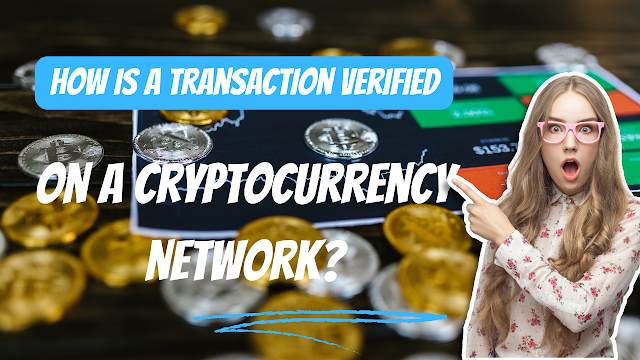Cryptocurrencies operate on decentralized networks, and the verification of transactions within these networks is a crucial process for ensuring trust, security, and validity. Understanding how a transaction gets verified involves delving into the intricate mechanisms underlying this digital phenomenon.
Introduction to Transaction Verification
 |
| How is a Transaction Verified on a Cryptocurrency network? |
In the realm of cryptocurrencies, transactions are fundamental actions that involve the transfer of digital assets between different addresses on the network. Unlike traditional financial systems, these transactions require verification without relying on a centralized authority.
The Role of Cryptography
At the heart of transaction verification lies cryptography, specifically cryptographic signatures. Each user on a cryptocurrency network possesses a pair of keys: a public key and a private key. When initiating a transaction, the sender signs it with their private key, creating a digital signature.
Nodes and Consensus Mechanisms
Nodes, the essential participants in a cryptocurrency network, play a pivotal role in transaction verification. They maintain copies of the blockchain and employ various consensus mechanisms to validate transactions, ensuring agreement across the network.
Transaction Verification Process
The process of verifying a transaction involves multiple steps. Once a transaction is initiated, it is broadcasted across the network, where nodes verify its authenticity. This verification process continues until the transaction receives a sufficient number of confirmations, indicating its inclusion in a block.
Mining and Miners
Mining, often associated with cryptocurrencies like Bitcoin, involves solving complex mathematical puzzles to validate transactions. Miners contribute computational power to secure the network and are rewarded for their efforts.
Security Measures in Verification
Security is a paramount concern in transaction verification. Networks implement various measures to safeguard against double-spending, fraud, and other potential vulnerabilities, ensuring the integrity of transactions.
Scaling and Transaction Speed
Transaction verification directly impacts the scalability and speed of a cryptocurrency network. As networks grow, challenges arise in handling increased transaction volumes. Innovations such as layer-two solutions aim to enhance throughput.
Real-Life Examples
Examining real-life examples of transaction verification in prominent cryptocurrencies like Ethereum, Bitcoin, and others provides insights into the effectiveness of different verification methods and the challenges faced by these networks.
Future Trends in Transaction Verification
Technological advancements continuously evolve transaction verification methods. Predictions indicate the adoption of more efficient and sustainable verification processes, contributing to network scalability and security.
Challenges and Solutions
Despite advancements, challenges persist in transaction verification, including scalability issues, energy consumption concerns, and regulatory hurdles. Solutions are being developed to address these challenges and ensure smoother operations.
Environmental Impact
The energy-intensive nature of certain consensus mechanisms, particularly Proof of Work, has sparked discussions about the environmental impact of transaction verification. Efforts are underway to explore greener alternatives.
Regulatory Considerations
Regulatory frameworks influence how transaction verification is conducted in cryptocurrencies. Compliance measures are designed to ensure legality, security, and user protection within these networks.
User Experience
Improving user experience in transaction verification is crucial for mass adoption. Simplifying the process and enhancing accessibility will encourage wider acceptance and usage of cryptocurrencies.
Educational Initiatives
Educational efforts are vital in empowering users to understand the complexities of transaction verification. Initiatives aimed at increasing awareness and knowledge play a pivotal role in ensuring secure transactions.
Conclusion
In conclusion, transaction verification in cryptocurrency networks is a multifaceted process that ensures trust and security without relying on a central authority. Understanding the intricacies behind this verification process is crucial for users navigating the digital financial landscape.
FAQs
-
What happens during transaction verification?
Transaction verification involves confirming the authenticity and validity of a transaction across a decentralized network of computers (nodes).
-
Why is transaction verification important in cryptocurrencies?
It ensures the integrity and security of transactions, preventing issues like double-spending and fraud without the need for a central authority.
-
How long does transaction verification take?
The time for verification varies depending on the network and the consensus mechanism used. Generally, it takes a few minutes to an hour for confirmation.
-
Can transaction verification fail?
While rare, verification can fail due to technical issues, network congestion, or invalid transaction information.
-
What role do miners play in transaction verification?
Miners validate transactions by solving complex mathematical puzzles, securing the network, and adding new blocks to the blockchain.

.jpg)
.jpg)

Please don't enter any spam link in the comment box.